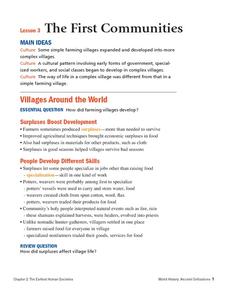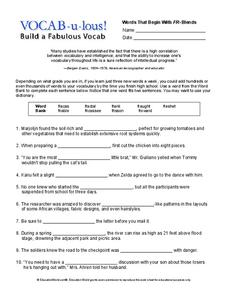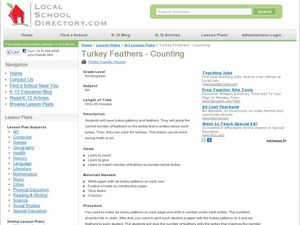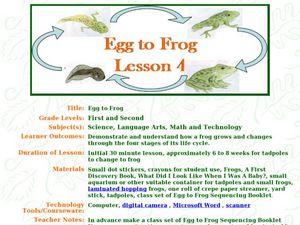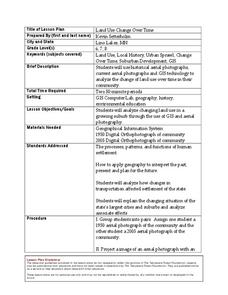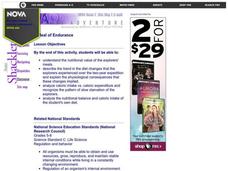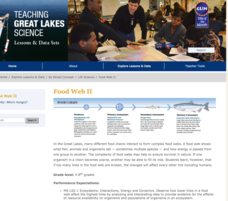Houghton Mifflin Harcourt
The First Communities
These documents list essential questions and foundational concepts associated with early civilizations and farming communities in the agricultural revolution. Use this as a starting point for developing specific lessons and activities...
Curated OER
In My Other Life
Students explore various cultural identities. They conduct Internet research, develop a questionnaire that profiles information from their selected culture, and write a letter to a pen pal in the U.S. explaining what life in their...
Curated OER
Vocab-u-lous! Build a Fabulous Vocab
In this vocabulary building worksheet, students enhance their personal vocabulary by learning words that begin with the FR-blends. Students are allowed to use dictionaries.
Curated OER
Paper Coil Baskets
Have your class learn about basket making with this resource. Learners talk about the techniques used to make baskets in Native American cultures. Then, they make baskets using paper coils. The results are attractive.
Curated OER
Population Biology
In this population instructional activity, students will compare two population growth graphs and complete four short answer questions. Then students will investigate the factors that influence population growth in 8 fill in the blank...
Curated OER
Turkey feathers- Counting
Students use turkey feathers to count. For this turkey feather counting lesson, students find the correct number of turkey feathers to correctly show the number.
Curated OER
Egg to Frog
Students study the life cycle of the frog. For this life cycle lesson set, students listen to a read aloud of Frogs, A First Discovery Book, and make a sequencing booklet that shows the four stages of the frogs life cycle. They observe...
Curated OER
Fifth Grade Life Science Review/Quiz
In this life sciences review or quiz instructional activity, 5th graders use recall of knowledge to answer multiple choice questions. Students answer 20 questions.
Curated OER
Product + 1: Integers
In this integers activity, high schoolers solve 1 word problem using proof. Students prove their hypothesis of the result of multiplying four consecutive positive integers and adding one to the product.
Curated OER
Story Dolls
Students express themselves through art and writing at the same time in this instructional activity. Students create paper doll versions of themselves. Students write a biography of their dolls.
Curated OER
Dating and Emotions
Learners explain how four areas of self-disclosure affect relationships. They evaluate their own comfort levels for self-disclosure. They identify components of communication.
Curated OER
A Changing Society: Industrialization and Urbanization
Students participate in activities that teach them about the Gilded Age of industrialization and urbanization. In this social changing lesson plan, students answer questions, watch videos, have discussions, read texts, and more to teach...
Curated OER
Animals Finding Rice Paddies
Fourth graders examine the animals who live in rice paddies and create a chart. In this rice lesson, 4th graders link the types of animals living in each ecosystem with a bar graph. Students use colored bars to show...
Curated OER
Land Use Change Over Time
Students use historical aerial photographs and current aerial photographs to compare the change over time to the land. In this land changing lesson plan, students analyze, compare, contrast, and list the land change in their own community.
Curated OER
Alternative Snowflakes
Students discover how snowflakes in nature are really formed, and recreate this process with paper and glue.
Curated OER
50 States: New England States
Students discover where certain states are located and what the look like. They look for their information on a web site. Each student is assigned a state which they must research then present to the entire class.
Curated OER
What is Hunger and Who are the Hungry?
Students aim to explain why we need food, to know that we need many different foods and to know who is hungry in the world.
Curated OER
Spending Plans
Students explore the concept of dividing their money into categories, namely "save," "spend," and "share." They engage in activities that help them explain that money is limited in quantity and must be divided for different purposes.
Curated OER
A Meal of Endurance
Students examine the importance of the nutritional value of explorers' meals. They investigate the concepts of caloric intake vs. caloric expenditure and examine their own nutrition.
Curated OER
Climate Change
Learners focus on the production of maple syrup in Northern New England as they study the effects of climate change. They investigate other environmental factors on the forests of Northern New England.
Michigan Sea Grant
Food Web II
A food web consists of complex food chains and the more complex the web, the better likelihood of survival. Learners compare and contrast food webs and food chains and discuss concepts like the predator-prey and consumer-producer...
Curated OER
A Lovely Captive
Fourth graders construct a habitat which allows them to observe the metamorphosis of a caterpillar into a butterfly. They place a plate on the bottom of the cylinder to serve as a landing platform. They use the cage for keeping adult...
Alabama Learning Exchange
How Old Is That Tree?
Fifth graders study environmental changes by examining the annual rings of a cross-section of a tree trunk. They access websites to complete a worksheet on the parts of a tree. They count the annual rings on a tree slice while observing...
Curated OER
"Garden Springs Gardeners"
First graders ponder the question of how plants help their lives. They observe and compare properties of several different plants. Differentiate between living organisms and nonliving objects.
Other popular searches
- Growing Patterns in Math
- Identifying Growing Patterns
- Growing Patterns Math
- Simple Growing Patterns
- Growing Patterns Activity
- Growing Patterns Worksheets
- Growing Patterns 100 Chart
- Growing Patterns That Double
- Growing Patterns en Espanol
- Growing Patterns in Nature
- Graphing Growing Patterns
- Growing Patterns and Rules
